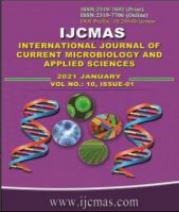


 National Academy of Agricultural Sciences (NAAS)
National Academy of Agricultural Sciences (NAAS)

|
PRINT ISSN : 2319-7692
Online ISSN : 2319-7706 Issues : 12 per year Publisher : Excellent Publishers Email : editorijcmas@gmail.com / submit@ijcmas.com Editor-in-chief: Dr.M.Prakash Index Copernicus ICV 2018: 95.39 NAAS RATING 2020: 5.38 |
Mustard crop is susceptible to many number of insect pests particularly mustard aphid (Lipaphis erysimi) a key pest which causes significant damage to the crop. To examine the incidence of aphid to different abiotic factors on Indian mustard (Brassica junceacv.Rohini) a field experiment was carried out at Institutional farm, Uttar Banga Krishi Viswavidyalaya, Pundibari, Cooch Behar, West Bengal for two successive Rabi seasons during 2016-17 and 2017-18. The prevalence of aphid population was first seen during the month of January (3rd Standard Meteorological Week) with 0.75 aphids/ top 10 cm apical shoot and it persisted in the field up to March (11th Standard Meteorological Week) with 52.12 aphids/ top 10 cm apical shoot. Maximum population of 85.33 aphids/top 10 cm apical shoot was recorded during February (8th Standard Meteorological Week) in 2016-17. Further, in 2017-18 the frequency of aphid was first noticed in the month of February (4th Standard Meteorological Week) with 5.0 aphids/top 10cm apical shoot and sustained in the field up to March (11th Standard Meteorological Week) with 2.14 aphids/top 10 cm apical central shoot. Peak population was observed during February (6th Standard Meteorological Week) with 50.33 aphids/top 10 cm apical shoot. Subsequently, correlation studies also made between aphid population and weather factors. Aphid was positively correlated with maximum and minimum temperature and negatively correlated with maximum relative humidity and positively correlated with minimum relative humidity and with rainfall it shows positive correlation. Aphid showed significant correlation with minimum temperature and maximum relative humidity during 2016-17. In 2017-18 aphid is negatively correlated with both maximum and minimum temperature, while positively correlated with both maximum and minimum relative humidity. Aphid is negatively correlated with rainfall.
 |
 |
 |
 |
 |